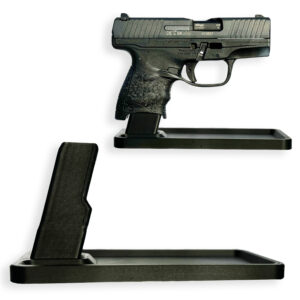
Categories:
In recent years, the debate surrounding gun control has become increasingly prominent, with particular attention being paid to the regulation of guns and related accessories. Among these accessories, gun magazines have emerged as a contentious topic within the legal landscape. A gun magazine refers to a device used to store and feed ammunition into a gun. These magazines come in various capacities, ranging from standard sizes to high-capacity or extended magazines.
The legal framework surrounding gun magazines is complex and varies significantly across different jurisdictions within countries like the United States. This variation has sparked intense discussions among policymakers, activists, gun enthusiasts, and concerned citizens alike.
At the crux of the debate lies the question of whether limitations should be placed on magazine capacity as a means to enhance public safety or uphold an individual’s Second Amendment rights. Proponents argue that restricting high-capacity magazines can potentially reduce casualties in mass shootings by limiting an assailant’s ability to fire multiple rounds without reloading. On the other hand, opponents contend that such restrictions infringe upon law-abiding citizens’ rights to self-defense and violate their constitutional freedoms.
To date, there is no consensus regarding magazine capacity limits at either federal or international levels. Consequently, regulations governing gun magazines vary significantly from state to state within countries like the United States. Some states have enacted strict laws prohibiting or severely restricting high-capacity magazines; others have chosen not to impose any specific limitations.
Furthermore, court decisions regarding magazine restrictions have created further complexity within this legal landscape. Several lawsuits have challenged state-level laws regulating magazine capacity on constitutional grounds, leading to conflicting rulings in different jurisdictions.
This text aims to explore and analyze various aspects of the legal landscape surrounding gun magazines across different jurisdictions while considering both sides of this polarizing debate. By examining relevant legislation, court cases, public sentiment, and potential policy implications associated with regulating gun magazines’ capacity limits, we seek an understanding of how this issue is being addressed in different legal systems.
The Second Amendment of the United States Constitution guarantees the right of citizens to keep and bear arms, which has sparked extensive debate and controversy regarding the legal landscape surrounding gun magazines. While the amendment itself does not explicitly mention gun magazines, understanding its implications provides valuable insights into how these accessories are viewed within the context of constitutional rights.
Interpretations of the Second Amendment have evolved over time, leading to varying understandings of its scope. The key debate revolves around whether it protects an individual’s right to own guns for self-defense or if it solely pertains to maintaining a well-regulated militia. This distinction has a direct impact on how gun magazines are legally regulated.
Supporters argue that limiting access to high-capacity gun magazines would infringe upon an individual’s right to self-defense as guaranteed by the Second Amendment. They contend that being able to possess larger capacity magazines allows individuals to better protect themselves in potentially life-threatening situations. Additionally, they argue that imposing restrictions on such accessories would undermine their effectiveness as a deterrent against potential aggressors.
On the other hand, opponents claim that stricter regulations on gun magazines are necessary for public safety concerns. They argue that high-capacity magazines increase the lethality and potential harm inflicted during mass shootings or criminal activities. By limiting magazine capacity, they believe law enforcement agencies will have more time to respond effectively during critical incidents.
The ongoing legal landscape surrounding gun magazines is shaped by different state laws and court rulings across America. Some states have enacted legislation banning or restricting high-capacity magazines, while others have sought to protect individuals’ rights by loosening regulations. Moreover, several court cases have challenged these laws, resulting in varying outcomes depending on jurisdiction.
In conclusion, understanding the implications of the Second Amendment is crucial when examining regulations concerning gun magazines. Debates continue regarding whether these accessories fall within an individual’s constitutional right or if public safety concerns justify restrictions. As the legal landscape evolves, finding a balance between protecting individual rights and ensuring public safety remains an ongoing challenge.
The issue of gun magazine capacity limits has been a contentious topic in the legal landscape surrounding guns in the United States. Federal regulations play a crucial role in determining the maximum number of rounds that a gun magazine can hold, aiming to strike a balance between individual rights to bear arms and public safety concerns.
At the federal level, there is no blanket ban on high-capacity magazines; however, certain restrictions do exist. The 1994 Federal Assault Weapons Ban (AWB) limited the capacity of detachable magazines to 10 rounds for guns classified as assault weapons. This ban expired in 2004 but has not been reinstated since, allowing for the legal sale and possession of high-capacity magazines across most states.
However, some states have enacted their own legislation concerning magazine capacity limits. California, for instance, restricts civilian possession of magazines holding more than ten rounds unless they were purchased before 2000 when a previous ban was enacted. Similarly, New York implemented its SAFE Act in 2013, limiting magazine capacity to seven rounds.
Moreover, federal law does impose restrictions on specific types of guns due to their design features rather than focusing solely on magazine capacities. For example, fully automatic guns or machine guns are tightly regulated under the National Guns Act (NFA) and require extensive background checks and approval from local law enforcement agencies.
It is important to note that even without federal restrictions on high-capacity magazines currently in place nationwide, individual states have varying laws that limit or prohibit their possession. These state-level regulations reflect different approaches towards striking a balance between personal liberties and public safety concerns surrounding gun usage.
In conclusion, while there are no federal regulations imposing blanket bans or restrictions on high-capacity gun magazines at present, some states have implemented their own legislation regarding maximum capacities allowed for civilian use. The debate over gun magazine capacity limits continues as policymakers grapple with finding an appropriate balance between individual rights and public safety.
In recent years, the legal landscape surrounding gun magazines has become a contentious issue across the United States. With mass shootings and gun-related crimes on the rise, many states have implemented strict regulations to curb the possession and use of high-capacity gun magazines. These state-level restrictions aim to reduce the potential for mass casualties and enhance public safety.
Several states have enacted bans on high-capacity gun magazines, defining them as those capable of holding more than a certain number of rounds, typically ranging from 10 to 15 rounds. California, for instance, has one of the most stringent regulations in place, prohibiting individuals from owning or manufacturing magazines that can hold more than 10 rounds. Violators face criminal charges and potential imprisonment.
Other states have adopted varying approaches to restrict access to high-capacity gun magazines. Some impose limitations on magazine capacity but allow individuals who owned such magazines prior to the enactment of these laws to keep them legally (“grandfather” clauses). New York’s SAFE Act is an example; it limits magazine capacity to seven rounds but allows pre-existing owners to continue possessing ten-round magazines.
Furthermore, some states prohibit not only the sale and possession but also the transfer or importation of high-capacity magazines. In Colorado, for instance, it is illegal to sell or transfer any magazine capable of holding more than 15 rounds since July 2013. However, individuals who already possessed such magazines before this date are allowed to keep them.
While state-level restrictions on high-capacity gun magazines vary significantly across jurisdictions, they all share a common goal: reducing harm by limiting access to guns with large ammunition capacities. Proponents argue that these regulations can potentially prevent mass shootings by making it harder for perpetrators to inflict significant harm in a short period. Opponents often challenge these restrictions as infringements upon Second Amendment rights guaranteed by the U.S. Constitution.
Overall, state-level restrictions on high-capacity gun magazines reflect the ongoing debate surrounding public safety and individual rights, as policymakers grapple with finding a balance between regulating guns and respecting constitutional principles.
In recent years, the legal landscape surrounding gun magazines has become increasingly contentious, with one of the key areas of debate being magazine capacity restrictions. These restrictions aim to limit the number of rounds that a gun’s magazine can hold. Proponents argue that such limitations promote public safety by reducing the potential lethality of mass shootings and increasing the likelihood for victims to escape or intervene.
However, opponents contend that these restrictions infringe upon Second Amendment rights and fail to effectively address underlying causes of gun violence.
One significant legal challenge to magazine capacity restrictions stems from Second Amendment arguments. Critics argue that these limitations unconstitutionally infringe upon individuals’ right to bear arms for self-defense purposes. They contend that restricting magazine capacities hinders law-abiding citizens from adequately protecting themselves, as they may be outnumbered or face multiple assailants in self-defense situations.
Furthermore, opponents assert that limiting magazine capacities does not effectively address the root causes of gun violence. They argue that individuals intent on carrying out mass shootings can easily acquire multiple magazines or modify guns to circumvent these restrictions, rendering them ineffective in preventing such incidents.
Several court cases have further fueled this legal battle over magazine capacity restrictions. For instance, in 2019, a federal judge blocked New York State’s ban on magazines capable of holding more than ten rounds, ruling it unconstitutional as it violated citizens’ Second Amendment rights. Similarly, in 2020, a federal appeals court struck down California’s ban on large-capacity magazines as an infringement on individual liberties.
As these legal challenges continue to unfold across different states and jurisdictions throughout the United States, it is clear that the issue of magazine capacity restrictions remains highly divisive and complex. Whether courts will ultimately uphold or strike down these limitations depends largely on how they balance public safety concerns with constitutional rights – a delicate task requiring careful consideration and analysis within our ever-evolving legal system.
The issue of “assault weapon” bans has long been a contentious topic in the realm of gun legislation. One aspect that often gets overlooked is the direct impact these bans can have on gun magazines. Gun magazines, commonly referred to as high-capacity magazines, are devices that hold more than a certain number of rounds, typically more than 10. As lawmakers grapple with questions surrounding public safety and individual rights, they must consider how these bans affect not only guns but also the accessories that accompany them.
Proponents of assault weapon bans argue that limiting magazine capacity can help reduce the lethality and potential harm caused by mass shootings. They believe that by restricting magazine size, shooters will be forced to reload more frequently, providing opportunities for intervention or escape during active shooter situations. These advocates contend that high-capacity magazines serve no legitimate sporting purpose and are unnecessary for self-defense.
Opponents of assault weapon bans argue that such measures infringe upon Second Amendment rights guaranteed by the United States Constitution. They believe that individuals have the right to possess guns with high-capacity magazines for various purposes, including self-defense and recreational shooting activities. Critics also question the effectiveness of such bans, arguing that determined criminals will find ways to obtain these accessories regardless of legal restrictions.
When assessing the legal landscape surrounding gun magazines in states with assault weapon bans, it is essential to understand the varying approaches taken by different jurisdictions. Some states impose outright prohibitions on high-capacity magazines, making their possession illegal regardless of whether they are used in conjunction with an “assault weapon.” Other states place restrictions on magazine capacity but allow certain exceptions for law enforcement or active-duty military personnel.
As debates over “assault weapons” continue nationwide, it is crucial to examine how proposed or existing laws impact gun accessories like high-capacity magazines. Balancing concerns regarding public safety while respecting individual rights remains at the forefront of these discussions, making it essential to find a middle ground that can satisfy both sides of the debate.
Recent court decisions have significantly shaped the legal landscape surrounding gun magazines, stirring debates and raising questions about Second Amendment rights and public safety. These rulings have addressed various aspects of magazine restrictions, including capacity limits, bans on certain types of magazines, and the constitutionality of such measures.
One prominent case that has influenced this legal landscape is Duncan v. Becerra. In 2020, the United States Court of Appeals for the Ninth Circuit struck down a California law that prohibited possessing high-capacity magazines. The court reasoned that these restrictions placed an unconstitutional burden on individuals’ right to self-defense, as defined by the Second Amendment. This decision marked a significant victory for gun rights advocates and set a precedent challenging similar laws in other states.
However, not all recent court decisions have been favorable to those seeking less restrictive regulations on gun magazines. In April 2021, the United States Court of Appeals for the Fourth Circuit upheld Maryland’s ban on large-capacity magazines in Kolbe v. Hogan. The court concluded that such restrictions do not substantially burden individuals’ Second Amendment rights and are justified by their potential to reduce harm in mass shootings or other dangerous situations.
These contrasting rulings reflect an ongoing debate between proponents of stricter gun control measures aimed at reducing gun violence and advocates who argue for broad interpretations of individual gun rights under the Second Amendment.
Furthermore, these court decisions have also highlighted challenges associated with defining what constitutes a “high-capacity” or “large-capacity” magazine. While some jurisdictions define these terms based on specific round capacities (e.g., over 10 rounds), others consider factors such as compatibility with certain guns or additional features like detachability or rapid reloading capabilities.
As more cases continue to make their way through state and federal courts nationwide, it remains uncertain how future rulings will shape the legal landscape surrounding gun magazines. Nevertheless, these recent decisions illustrate an evolving battleground where constitutional rights intersect with public safety concerns regarding guns possession and use.
In recent years, the issue of gun control has become a highly debated and contentious topic in many countries, particularly regarding the regulation of guns and related accessories. One specific area of focus within this broader discussion is the legal landscape surrounding gun magazines – devices used to hold and feed ammunition into guns. As concerns about public safety and mass shootings persist, lawmakers have proposed various pieces of legislation aimed at regulating or even banning certain types of gun magazines.
Advocates for stricter gun control argue that limiting magazine capacity can help reduce the potential for mass casualties during shootings. They contend that by restricting the number of rounds a magazine can hold, it would force shooters to reload more frequently, providing opportunities for potential victims to escape or intervene. In response to these concerns, legislators have put forth several proposals targeting high-capacity magazines.
One common proposal involves limiting magazine capacity to a specific number of rounds, such as ten or fifteen. Proponents argue that this restriction strikes a balance between respecting Second Amendment rights and addressing public safety concerns. They assert that most self-defense situations do not require an excessive number of rounds, thus making these limitations reasonable.
Another approach is an outright ban on high-capacity magazines altogether. Supporters argue that such magazines are primarily designed for military-style weapons and have no legitimate civilian use. By prohibiting their sale and possession, proponents believe it would make it significantly harder for criminals to carry out large-scale attacks.
However, opponents argue against these proposed regulations, asserting that they infringe upon individuals’ Second Amendment rights without substantial evidence demonstrating their effectiveness in preventing crime or reducing casualties during shootings. Critics further contend that law-abiding citizens should not be penalized due to the actions of a few criminals.
As debates surrounding gun control continue across nations worldwide, the proposed legislation related to regulating or banning certain types of gun magazines remains a central point of contention among lawmakers grappling with public safety concerns and individual rights.
The legal landscape surrounding gun magazines has witnessed significant changes in recent years, and several emerging trends and future developments are expected to shape the regulatory framework governing these devices. With the ongoing debates on gun control, policymakers and courts are grappling with various issues related to the possession, sale, and use of high-capacity magazines. This subtopic explores some of the key trends that have emerged, as well as potential future developments that may impact the legal landscape for gun magazines.
One prominent trend in recent years has been the implementation of state-level restrictions on high-capacity magazines. Several states have enacted legislation limiting magazine capacity to a certain number of rounds, typically between 10 and 15. These restrictions aim to reduce mass shooting incidents by limiting the number of rounds a shooter can fire without reloading. As this trend gains momentum, it is likely that more states will adopt similar restrictions or expand existing ones.
Another emerging trend relates to judicial interpretations of Second Amendment rights as they pertain to gun magazines. Courts have grappled with balancing individuals’ rights to possess guns against public safety concerns raised by high-capacity magazines. Some courts have upheld restrictions on magazine capacity while others have struck them down as unconstitutional infringements on Second Amendment rights. The evolving judicial landscape will continue to shape future regulations regarding gun magazines at both state and federal levels.
Additionally, technological advancements may influence future developments in regulating gun magazines. The emergence of 3D-printed guns raises concerns about undetectable or untraceable weapons equipped with high-capacity magazines that could potentially bypass existing regulations altogether. Policymakers will need to navigate this rapidly advancing technology and adapt regulations accordingly.
In conclusion, the legal framework surrounding gun magazines is undergoing significant changes driven by emerging trends and potential future developments. State-level restrictions on magazine capacity, evolving judicial interpretations of Second Amendment rights, and technological advancements all contribute to the evolving landscape. Policymakers and courts will continue to grapple with striking a balance between individual rights and public safety concerns while adapting regulations to address emerging challenges in this contentious area.








Colt
Colt M4 Carbine
Colt LE6920
Colt AR-15 A4
Daniel Defense
DDM4 V7
DDM4 V9
DDM4 V11
DDM4 ISR (Integrally Suppressed Rifle)
Smith & Wesson (S&W)
M&P15 Sport II
M&P15 Tactical
M&P15T
Bravo Company Manufacturing (BCM)
BCM Recce-16
BCM Recce-14
BCM MCMR Series
Aero Precision
M4E1 Series
AC-15
AR15 Pistol (Various Configurations)
Ruger
Ruger AR-556
Ruger SR-556
Ruger AR-556 MPR (Multi-Purpose Rifle)
Springfield Armory
Saint Victor
Saint Edge
Saint AR-15
PSA (Palmetto State Armory)
PSA PA-15
PSA AR-V
PSA Jakl (AR Pistol)
FN America
FN 15 Tactical Carbine
FN 15 Patrol
FN 15 DMR
Wilson Combat
Recon Tactical
Super Sniper
Protector Carbine
SIG Sauer
SIG M400 Tread
SIG M400 Elite
SIG M400 SDI
LWRC International
IC DI (Direct Impingement)
IC SPR
IC A5
Bushmaster Guns
XM-15 QRC
Bushmaster MOE
XM-15 Patrolman
Rock River Arms
LAR-15 Entry Tactical
LAR-15 Predator
LAR-15 Elite Comp
Stag Arms
Stag 15 Tactical
Stag 15L (Left-Handed Models)
Stag 15 Valkyrie
Noveske Rifleworks
Noveske Gen 4 N4
Noveske Space Invader (AR Pistol)
Noveske Recon
Anderson Manufacturing
AM-15 Optic Ready
AM-15 M4 Carbine
AM-15 Precision Rifle
Adams Arms
AA-15 Piston Rifle
P2 AARS (Adams Arms Rifle Series)
Black Rain Ordnance
SPEC15 Series
BRO Predator
Fallout 15
Diamondback Guns
DB15 Series
DB15CCMLB
DB15EB
Del-Ton Inc.
DTI-15
Del-Ton Echo 316H
Sierra 316M
Windham Weaponry
Windham SRC
Windham VEX-SS
Windham RMCS-4 (Caliber Conversion System)
Christensen Arms
CA-15 G2
CA-15 Recon
CA-15 Titanium Edition
Patriot Ordnance Factory (POF-USA)
Renegade Plus
P415 Edge
Revolution DI
LaRue Tactical
PredatAR
OBR (Optimized Battle Rifle)
LaRue Stealth 2.0
Battle Arms Development
Workhorse Patrol Carbine
BAD556-LW (Lightweight)
Authority Elite Rifle
Faxon Guns
Ascent AR-15
FX-19 (AR Pistol)
Streamline Ultralight Series
KE Arms
KE-15 SLT (Super Lightweight Tactical)
KE-15 Scout Carbine
Primary Weapons Systems (PWS)
MK1 MOD 2-M
MK116 PRO
MK107 (Piston AR Pistol)
ZEV Technologies
ZEV Core Elite Rifle
ZEV AR15 Billet Rifles
Franklin Armory
BFSIII AR-C1
Militia Model
F17-L (Chambered in .17 WSM)
Seekins Precision
SP15 DMR
NX15 Skeletonized Rifle
Havak Bravo
Aero Precision (Additional Models)
EPC-9 (Pistol Caliber ARs)
VG6 AR Rifles
Barrett Guns
REC7 DI
REC7 Gen II
CMMG
MK4 RCE
Resolute 300
Banshee (AR Pistol)
DPMS Panther Arms
Panther Oracle
Panther LR-308
H&K (Heckler & Koch)
HK MR556A1
HK416 (Military Variant)
Rock Island Armory (Armscor)
VR-80 Tactical AR (Shotgun AR Platform)
Troy Industries
Troy SPC-A3
Troy PAR (Pump Action AR)
Wilson Tactical
Tactical Recon AR
Protector Series
F1 Guns
FDR-15 Skeletonized Rifle
BDRx-15 Series
Juggernaut Tactical
JT-15
JT-10 Precision Rifle
AeroSurplus
Surplus AR-15 Rifles (Budget Models)
Thunder Tactical
AR-15 Basic Carbine
Tactical Builder Sets
Radical Guns
RF-15
Forged AR-Series
Dark Storm Industries
DS-15 Featureless Rifles
DS-10 Typhoon
DRD Tactical
Paratus
Aptus AR Rifles
Bear Creek Arsenal
BCA-15
AR Complete Upper Builds
Aero Survival Rifles (ASI)
ASR Tactical Series
Tactical Edge
WARFIGHTER Series
AR-15 Lightweight Rifles
Lone Star Armory
TX15 DMR
TX15 Carbine
HERA Arms
HERA H7
HERA AR-15 Lower Builds
IWI (Israeli Weapon Industries)
Zion-15
DRD Tactical
Tactical Modular Rifles
Quick-Takedown Rifles
V Seven Weapons
1776 Rifle
Hyperlite Rifle
Core Rifle Systems
Core15 Tac III
Core15 Patrol Rifle
Armalite (Original AR-15 Creator)
M15 Tactical
M15 A4 Carbine
DEF15 (Defensive Sporting Rifle Series)
PSA (Palmetto State Armory Additional Models)
PSAK-47 Hybrid (AR-AK Style Hybrid)
PSA Dagger (Pistol Caliber Configurations)
Odin Works
OTR-15
Odin Recon Rifle
Maxim Defense
MDX-508 PDX (Compact AR Pistol)
MDX-510 Rifle